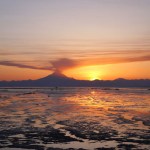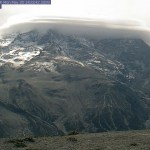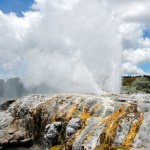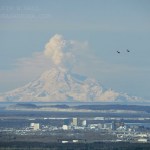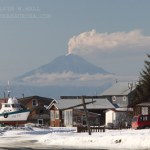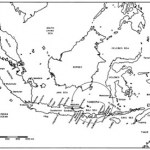volcanoes and the economy
This will likely be my last new post for the next week or so. I'll be off to my home town for a wedding and a reunion. If you're jonesing for up to date volcano info, be sure to visit the Volcanism Blog or the European Volcanological Society news page. Feel free to post any other links you know or breaking volcano news over on the open thread as well! I will be posting a couple pieces over this next week, including the next volcano profile, so stay tuned for those as well. Regular posting of new volcano news should return June 15.
Mt. Redoubt in Alaska steaming in spring 2009. Image courtesy…
This week's edition of Wednesday Whatzits could have been called "Miércoles Materia" as all the updates are for South American volcano. Enjoy!
Tungurahua in Ecuador
(Note: all links in spanish)
INGEOMINAS in Colombia is reporting that Nevado del Huila experienced 343 earthquakes over the past week, suggesting that something is brewing at the volcano. This has been accompanied by gas emissions and ash from the fractured dome. The Volcano Observatory in Popayán mentions that more than half of the earthquakes are related to magma moving into the system. Huila remains at Level III (Yellow)…
Redoubt steaming away on May 4, 2009. Image courtesy of AVO/USGS
Fairly quiet weekend (except for the start of the College World Series regionals ... I do have a favored team*), volcanically speaking, but the ever-vigilant folks up in Alaska are keeping an eye on Redoubt as the eruption of 2009 continues.
The weekly status (released 5/29) for Redoubt released by AVO has no big surprises, reporting that "small discrete earthquakes and rockfall signals in the summit region have been recorded steadily over the course of the past week. In other words, the dome continues to extrude and part of it…
Lenticular clouds forming over Redoubt on May 25, 2009. Image courtesy of AVO/USGS and sent to me by Eruptions reader Todd Russell.
We haven't talked much about Redoubt lately, so I thought I'd add a brief update. First off, the Alert Level at the volcano still sits at Orange/Watch status, meaning that although the volcano is not erupting, it could at almost any time.
Most of the threat of eruption stems from the ever-growing lava dome on the volcano. AVO noted today that the "Hut webcam views today show evidence of recent rockfall activity, including a fresh ash deposit to the east (left)…
Al-Qider volcano in western Saudi Arabia. Image courtesy of Ahmed Al-Hussaini.
After a week's worth of worry, it appears that the seismicity in western Saudi Arabia is subsiding. The latest statement from Zuhair Nawab, the head of the SGS, is that over the past four days with fewer and less severe aftershocks. If this continues, people who have evacuated the area around Al Ais might be able to return to their homes in a few days. However, it is important to note that even though officials suggest the seismicity is waning (and there may be indications this is not entirely accurate), the swarm…
Pohutu Geyser in Rotorua, New Zealand. Image taken by Erik Klemetti in January 2009.
It has been busy busy week for me, capped off today with a talk about my field work in New Zealand (see above), so I don't have much to say. Not much new news today about the Saudi Arabian earthquake swarms, but again, I'll keep my eyes pealed (incidentally, I still haven't been able to figure out why no western news sources have even mentioned the swarm).
Anyway, here's are some volcanic tidbits to enjoy over the long weekend:
Vog, as seen from space. Volcanic fog, fashionably shortened to "vog" is a real…
Manam in Papua New Guinea erupting in 2004
Five years ago, Manam volcano in Papua New Guinea erupted. The volcano is located on a 10-km island of the same name and when it erupted in 2004, it produced pyroclastic flows and lava flows to the tune of a VEI 4 eruption. It was decided that the 9,000 inhabitants of the island had to be evacuated but even so, five people died due to the eruption. However, there are still thousands of people in temporary care centers on the main island of Papua New Guinea. Tensions have flared with the local inhabitants, to the point that four former islanders have…
Things are busy - both volcanically and personally - so I'm going to just give you some links to a bunch of exciting/interesting/insane news:
West Mata erupting on May 5, 2009 in the Lau Basin.
According to a bunch of news sources, the eruption at Fernandina in the Galapagos is over (in spanish). That being said, the PNG noted that there is still a lot of carbon dioxide and sulfur dioxide being emitted, suggesting there is still a lot of degassing magma beneath the vents - at what depth (and will it erupt) is the question.
There is a lot of speculation that Nyiragongo (DRC) is erupting or…
Redoubt in April 2009 with Anchorage in the foreground (along with two F-22 Raptors). Image courtesy of Calvin Hall.
It has been quite some time since I talked about Redoubt, mostly because the volcano has been in the "slow extrusion of a dome" mode that has not generated much beyond impressive steam (with some ash) plumes. The volcano continues to stay at Orange/Watch status. I did glean a few interesting facts and speculations about the future at Redoubt from Dr. Jake Lowenstern of the USGS the other day, including:
The new dome growing on the volcano has more room to expand than the 1989…
Volcano monitoring. Image courtesy of the USGS.
Last night I had the opportunity to see a talk given by YVO Scientist-in-Charge Dr. Jake Lowenstern as part of the Volcanological Society of Sacramento meeting and he gave a great talk on the state of volcano monitoring today in the U.S. He laid out a lot of details concerning the Volcano Hazards Program of the USGS and I thought I'd share some of them so we can all have an idea of the ups and downs of the VHP these days.
First off, nothing says fun like the U.S. Volcano Status Map! Apparently the dreaded watch "eye" was not meant to be a…
Just a quick note before I'm off to this ...
Llaima
The SERNAGEOMIN is evaluating whether the alert level at Llaima should be lowered to Yellow in the near future (in spanish). Seismic acitivity at the volcano have come down since the eruptions started a few weeks ago and most of the activity now seems to be fumarolic in nature.
Popocatépetl
Popo (as it is also called) continues to produce steam/gas plumes (in spanish), 5 in one day on Monday of this week. However, all the other usual volcanic monitoring parameters (seismicity and the like) are unchanged according to Cenapred (National…
Redoubt from Ninilchik, AK. Image courtesy of Calvin Hall.
It has been a few days since we've talked about Redoubt. Well, it might be because the volcano has settled down for the past week, to the point that AVO put the volcano back to Orange/Watch status last week and hasn't had to go back to Red/Warning since. This is not to say the Redoubt is quiet, on the contrary, there is still elevated seismicity, an almost-constant steam/ash plume up to 15,000 feet / 5,000 meters and most importantly, the new dome (below) is still growing near the summit. The system has been actively degassing carbon…
Active US volcanoes and volcano observatories
After all the well-publicized words of "a certain governor in the lower forty-eight" (as Sen. Begich (D-AK) likes to call him) the "wasteful" spending on volcano monitoring improvements in the U.S. have become reality. Sec. of the Interior Ken Salazar announced $15.2 million dollars to modern the infrastructure of the nation's volcano monitoring networks (that is out of the ~$3 billion that went to the Interior - making volcano monitoring a whopping 0.5% of the stimulus that went to that department). Much of this money will likely go to one of…
Tambora, Indonesia
There are big eruptions, then there are big eruptions. On April 10, 1815, Tambora, a volcano in Indonesia, produced one of the largest eruptions in human history. This eruption produced what became known as the "year without a summer" after the volcanic aerosols from the eruption produced some of the coldest summers in many parts of the world. The Tambora eruption in 1815 was a VEI 7, on a scale that goes to, well, 7*, putting it in a class of some of the largest and most violent eruptions imaginable - and I, for one, can hardly imagine what might happen if an eruption of…
Canlaon volcano, Philippines
Geothermal energy is one of those sources of energy that might be able to solve a lot of the planet's energy problems - heck, the Earth has a lot of heat it is trying to get rid of, so taking that heat and turning into energy seems like an easy (and clean?) way to stop using fossil fuels and the like. Of course, like any supposed panacea, it has its problems.
However, one aspect that gets people are riled is whether drilling into areas of active magmatism might actually cause volcanism. Just in the last few weeks, a controversy was sparked in the Philippines…
Hunga Tonga Hunga Ha'apai, taken in late March 2009
Redoubt did the tried-and-true American trick of shoving news of volcanoes in other parts of the world off the news pages, but shockingly, these international volcanoes continued to erupt. Remember that volcano in Tonga? Hunga Tonga Hunga Ha'aapi? Still erupting, weeks after the volcano was first spotted. The volcano is still disrupting air traffic in and out of Tonga, which is now even affecting the economy of the islands. Now, the problem is that tourists are creeping ever closer to the emerging volcanic island. The thing about visiting…
